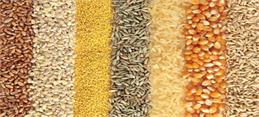Lesson 14. 1. Cereal or grain crops
Grammar activities
1. Highlight the words with the suffix –er according to its function.
1. суффикс существительного,
2. суффикс сравнительной степени прилагательного,
3. часть основы слова:
warmer, summer, grower, earlier, proper, later, flower, producer, feeder, another, breeder, drier, roller, finer, helper, mixer, rather, fiber.
2. Translate the sentences containing the Complex Object.
1. We know organic matter to affect soil fertility greatly.
2. Any student knows different crops to require different kinds of seedbed.
3. The agronomist says this soil to be rich in all nutrients.
4. The farmer believes the application of commercial fertilizers to improve soil fertility.
5. All farmers know proper preparation of the seedbed to insure a good stand.
6. We know the time of sowing to depend on the variety chosen as well as on the moisture conditions of the soil.
3. Find the complex object in text A (para. 1, 3, 4).
Vocabulary Focus

| Handwrite the words and word combinations related to text A and give their Russian equivalents. Check them in the agronomy and soil science dictionaries. |

| cool-season crop, warm-season crop, to crop, temperate, moderate, ground, straw, tall, shallow, weak, excessive, similar, case, to remain, reason, rather, although, per, total, a number of, relatively. |
4. Translate text A.
Text А
Cereal or grain crops
 |
Cereals are those members of the grass family which have edible starchy seeds. Everybody knows wheat, barley, rye, oats, maize (known as corn in America), rice, sorghum and millets to be most common cereals. They are all spring or winter annuals, that is, they complete their life cycle in a single growing season. The temperate zone cereals or cool-season species known as small grains (wheat, barley, oats, and rye) are to be planted in the fall or spring and harvested in mid-to-late summer. The rest1 of the cereals belong to warm-season species sown in late spring or early summer and harvested in the fall. The main aim in growing cereals is to produce grain to be used either as human food or as feed for livestock.
Of the cereals raised wheat, rice and corn are the world's three major grain crops, all being about equally important in terms of world production. Although rice seems to constitute the main food of more people, wheat is the first in importance on a world scale of all the cereals as to both the total area sown and the annual production. It is the principle source of carbohydrates for human nutrition.
There is a number of reasons why cereals are the man's leading food source. We know cereals to be annuals, that is why they produce food in a relatively short period of time. In addition, they are adapted well to a variety of4 soils, climates and cropping systems. Because cereals require relatively little labour, large areas of land can be cropped, and the return in terms of food per unit of labour is high. They are known to be rather resistant to diseases and insects. But above all5 the grain the cereals produce is easily harvested, cleaned and stored, all these operations, including sowing, being highly mechanized.
General cultural practices required in growing grain crops are quite similar. It is known that they do best on moderately fine but not pulverized seedbeds containing a proper amount of moisture near the soil surface. The seeding depth has been found to vary from 1 to 3 inches. The farmer cannot expect cereals to grow well if they have been sown too shallow because in this case the plants will be poorly supplied with water due to its evaporation from the soil surface.
A problem common to all cereals is lodging resulting from excessively high rates of nitrogen and heavy seeding rates which may produce tall, weak-stemmed plants6 that fall to the ground. The aim of plant breeders is to develop dwarf stiff-strawed7 varieties that will not lodge.
Though cereals do not supply enough protein and vitamins necessary for a balanced diet, they are sure to remain a major source of food for people throughout the world.
Notes to the text
1. the rest – остальные;
2. in terms of– с точки зрения: в переводе на;
3. a number of – ряд;
4. a variety of - ряд, разнообразие, множество;
5. above all – прежде всего;
6. week-stemmed plant – растение со слабой соломиной;
7. stiff-strawed plant - растение с крепкой соломиной.
Grammar and vocabulary activities
5. Specify the sentences containing the Complex Object.
1. This crop is likely to belong to the grass family.
2. All students of agriculture know both spring and winter wheats to be annuals.
3. The farmer expects the green manure he has plowed under to improve the soil structure
4. Much nitrogen is sure to cause lodging in.
5. Agriculturists know continuous cereal growing to result in the loss of organic matter from the soil.
6. Plants are to absorb most of their nutrients from the soil
7. Winter hardiness is considered to be of great importance in winter varieties.
8. Oats are believed to be not so cold resistant as wheat and barley.
7. Give the Russian equivalents of the following words and word combinations.
to do well, available nutrients, too acid, continuous cereal growing, proper crop sequence, commercial fort application, high organic matter content, early spring dressing, a number of cultural practices, temperate zone crops, both the total area and annual production, a variety of reasons, per unit of area, to a considerable extent, unless, until, in order to ...., to result in, to result from, one should, is of high quality, most, that is, that is why, the former, the latter, whether.








